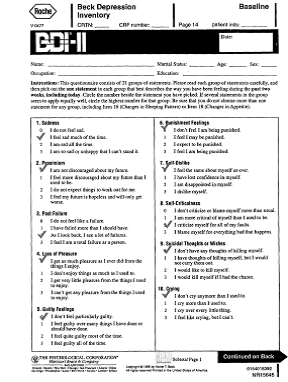
Beck, is a 21-question multiple-choice self-report inventory, one of the most widely used psychometric tests for measuring the severity of depression. This depression inventory can be self-scored. The scoring scale is at the end of the questionnaire.
I am not particularly discouraged about the future. Items involving changes in body image, somatic preoccupation, and work difficulty were replaced. The Beck keeps getting better! BDI - II Instructions: This questionnaire consists of groups of statements.
Please read each group of statements carefully. And then pick out the one statement in each group that best describes the way you have been feeling during the past two weeks, including today. Circle the number beside the statement you have picked.
Although the psychometric properties of the scale have been well established through many studies worldwide, so far there is no study examining the validity and reliability of BDI- II in Republic Dominican. The purpose of the present study. Items from the BDI-A were rewritten, new items corresponding to DSM-IV Depression criteria were adde and the timeframe was changed from week to weeks to correspond to the DSM-IV.
It has also been used in numerous treatment outcome studies and in numerous studies with trauma-exposed individuals. Assess depression severity criteria fast with BDI- II. Developed by Beck et al.

For children and adolescents ages. Arnau RC, Meagher MW, Norris MP, Bramson R. Beck AT, Guth Steer RA, Ball R. Although the number of items and response style remains the same as with the original version, the item content was modified to address all DSM-IV criteria. Beck , is a 21-question multiple-choice self-report inventory, one of the most widely used instruments for measuring the severity of depression. Retrieved from Capella Library.
For example, individuals are asked to respond to each question based on a two-week time period rather than the one-week timeframe on the BDI. Psychological Assessment. Administration of the Beck Hopelessness Scale or other appropriate assessment procedure is recommended. Beck Depression Inventory II (BDI- II ) - Sadness scale Scale identifying level of sadness, as part of the Beck Depression Inventory II (BDI- II ). It can be used for screening, diagnosis, and monitoring of therapeutic progress in both inpatient and outpatient settings.

Each item is rated on a 4-point scale ranging from to 3. The ma ximum total score is 63. Special attention must be paid to the correct scoring of the Changes in Sleeping Pattern (Item 16) and Changes in Appetite (Ite m 18) items. The questionnaire is composed of items relating to depression symptoms such as hopelessness and irritability, cognitions such as guilt or feelings of being punishe as well as physical. It maintains the item structure from the BDI– II and rates items occurrence over the past two weeks.
If, after taking any of these assessments, you feel you really may be clinically depresse then consider reaching out to a depression hotline, or find a mental health professional in your area. Both measures demonstrated high internal reliability in the full student sample. Its development marked a shift among health care professionals, who had until then viewed depression from a psychodynamic perspective, instead of it being.
In this particular article, I. Therefore, we investigated 1) which of the five evaluated measurement models had the best fit, 2) the scale’s reliability, and 3) the scale’s convergent validity.
No comments:
Post a Comment
Note: Only a member of this blog may post a comment.